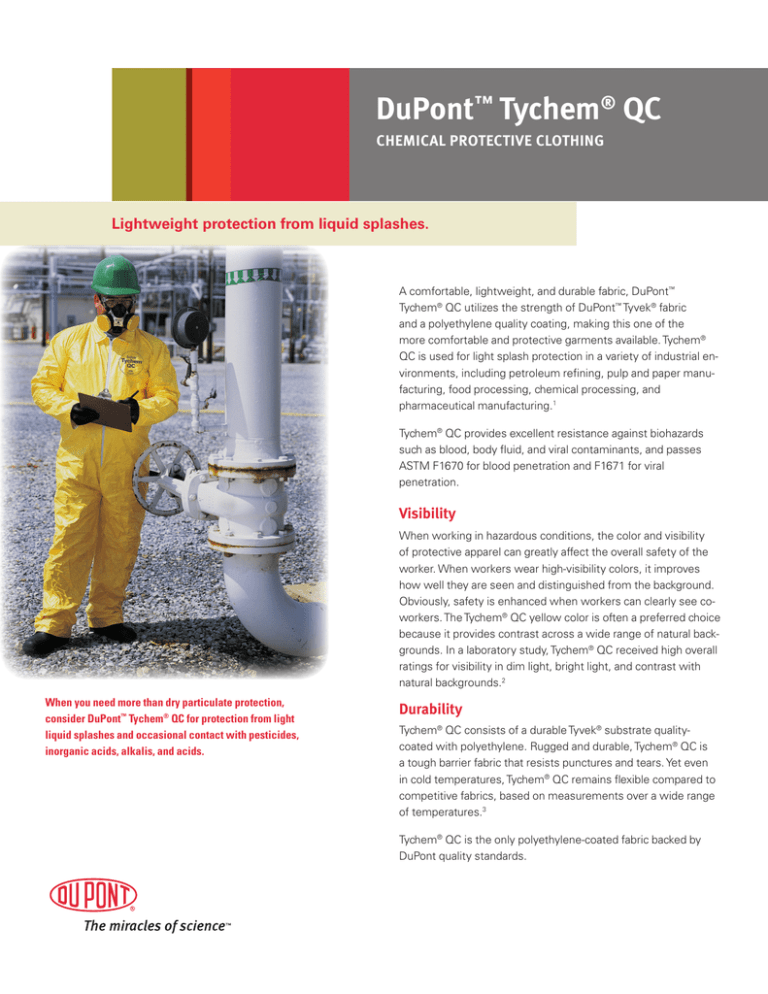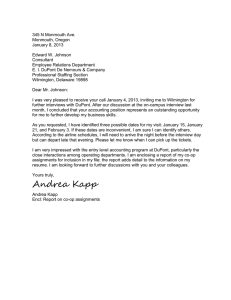
DuPont™ Tychem® QC
chemical protective clothing
Lightweight protection from liquid splashes.
A comfortable, lightweight, and durable fabric, DuPont™
Tychem® QC utilizes the strength of DuPont™ Tyvek® fabric
and a polyethylene quality coating, making this one of the
more comfortable and protective garments available. Tychem®
QC is used for light splash protection in a variety of industrial environments, including petroleum refining, pulp and paper manufacturing, food processing, chemical processing, and
pharmaceutical manufacturing.1
Tychem® QC provides excellent resistance against biohazards
such as blood, body fluid, and viral contaminants, and passes
ASTM F1670 for blood penetration and F1671 for viral
penetration.
Visibility
When working in hazardous conditions, the color and visibility
of protective apparel can greatly affect the overall safety of the
worker. When workers wear high-visibility colors, it improves
how well they are seen and distinguished from the background.
Obviously, safety is enhanced when workers can clearly see coworkers. The Tychem® QC yellow color is often a preferred choice
because it provides contrast across a wide range of natural backgrounds. In a laboratory study, Tychem® QC received high overall
ratings for visibility in dim light, bright light, and contrast with
natural backgrounds.2
When you need more than dry particulate protection,
consider DuPont™ Tychem® QC for protection from light
liquid splashes and occasional contact with pesticides,
inorganic acids, alkalis, and acids.
Durability
Tychem® QC consists of a durable Tyvek® substrate qualitycoated with polyethylene. Rugged and durable, Tychem® QC is
a tough barrier fabric that resists punctures and tears. Yet even
in cold temperatures, Tychem® QC remains flexible compared to
competitive fabrics, based on measurements over a wide range
of temperatures.3
Tychem® QC is the only polyethylene-coated fabric backed by
DuPont quality standards.
Permeation
Documentation is available on how DuPont Tychem QC
performs against more than 80 chemicals. DuPont makes
the only polyethylene-coated fabric for which testing data
is provided. This testing data provides detailed information on
how well this fabric performs against various chemical classes.4
™
®
Permeation Data for ASTM Recommended List
of Chemicals for Evaluating
Protective Clothing Materials (ASTM F1001)
Challenge
Chemical
Physical
Phase
Average
Breakthrough
Time, min.
Average
Permeation
Rate,
µg/cm2/min.
L
immed.
10
Note: While the uncoated DuPont™ Tyvek® substrate performs well in tests with
light splash with low pressure, DuPont™ Tychem® QC passes penetration tests that
include high pressures.
Acetone
Acetonitrile
L
immed.
16
Pesticides: To determine the appropriate garment for a liquid application, read the
EPA Product Registration Label. If the signal word is “CAUTION” or “WARNING”
(only one will be listed), Tychem® QC may be the appropriate choice. If the signal
word is “DANGER”, Tychem® SL may be appropriate.
Anhydrous ammonia
G
immed.
3.1
1,3-Butadiene
G
immed.
12
Carbon disulfide
L
immed.
high
Chlorine
G
immed.
>50
Dichloromethane
L
immed.
>50
Diethyl amine
L
immed.
216
Dimethyl formamide
L
immed.
0.72
Ethyl acetate
L
immed.
high
Ethylene oxide
G
immed.
167
ASTM E 308-95 — ”Standard Practice for Computing Colors of Objects by Using the CEI System.”
Hexane
L
immed.
high
ASTM D747 — ”Apparent Bending Modulus of Plastic by Means of a Cantilever Beam.”
Hydrogen chloride
G
immed.
9.3
Methanol
L
immed.
high
Methyl chloride
G
immed.
0.23
Nitrobenzene
L
immed.
18
Sodium hydroxide
L
>480
<0.1
Sulfuric acid
L
>480
<0.1
Tetrachloroethylene
L
immed.
high
General Garment Specification/Wear Guidelines: Potential for light splash AND no pressure — Select serged seam
construction for small volumes of fluids with minimal or no pressure.
1
Potential for light to moderate splash — Select bound seams that are tightly sewn and have a reinforced outer
binding to enhance seam strength and barrier quality.
Potential for moderate to heavy splash — Select sewn and taped seams that offer higher strength and penetration
resistance. All apparel used in liquid applications should
have bound or sealed seams. A storm flap that covers zipper/closure area should also be considered. In the event
of a splash or drench, the contaminated garment should be removed and clean apparel donned.
2
3
DuPont Publication —”Permeation Guide for DuPont™ Tychem® & DuPont StaSafe® Protective Fabrics.”
4
Typical Physical Properties
of DuPont™ Tychem® QC
Property
Total Basis Weight, oz/yd
2
Thickness, mil
Mullenburst, psi
Breaking Strength Grab, md/cd, lb
Tearing Strength Trapezoid, md/cd, lb
Units
Standard
2.5
ASTM D3776-90
Tetrahydrofuran
L
immed.
183
10
ASTM D1777-75
Toluene
L
immed.
high
71
ASTM D3786-87
41/47
ASTM D5034-90
7/5
ASTM D1117-80
Index of Codes:
> = greater than, < = less than, L = liquid, G = gas, immed. = immediate (<10 minutes)
Numbers reported are averages of samples tested by the ASTM F739 test method.
Sample results do vary and therefore averages for these results are reported.
This information is based upon technical data that DuPont believes to be reliable. It is subject to revision as additional
knowledge and experience are gained. DuPont makes no guarantee of results and assumes no obligation or liability in
connection with this information.
It is the user’s responsibility to determine the level of toxicity and the proper personal protective equipment needed. The
information set forth herein reflects laboratory performance of fabrics, not complete garments, under controlled conditions.
It is intended for information use by persons having technical skill for evaluation under their specific end-use conditions,
at their own discretion and risk.
Anyone intending to use this information should first verify that the garment selected is suitable for the intended use.
In many cases, seams and closures have shorter breakthrough times and higher permeation rates than the fabric.
Please contact the garment manufacturer for specific data. If fabric becomes torn, abraded or punctured, end user
should discontinue use of garment to avoid potential exposure to chemical. SINCE CONDITIONS OF USE ARE OUTSIDE
OUR CONTROL, WE MAKE NO WARRANTIES, EXPRESSED OR IMPLIED, INCLUDING, WITHOUT LIMITATION, NO
WARRANTIES OF MERCHANTABILITY OR FITNESS FOR A PARTICULAR USE AND ASSUME NO LIABILITY WHATSOEVER
IN CONNECTION WITH ANY USE OF THIS INFORMATION.
This information is not intended as a license to operate under or a recommendation to infringe any patent, trademark or
technical information of DuPont or others covering any material or its use.
WARNINGS: 1) Tychem® QC is not flame-resistant and should not be used around heat, flame, sparks or in potentially
flammable or explosive environments. 2) Garments made of Tychem® QC should have slip-resistant or antislip materials on
the outer surface of boots, shoe covers or other garment surfaces in conditions where slipping could occur.
Copyright © 2007 DuPont. The DuPont Oval Logo, DuPont™, The miracles of science™, Tyvek®, and Tychem® are registered trademarks
or trademarks of E.I. du Pont de Nemours and Company or its affiliates. All rights reserved.
K-17394 (09/07) Printed in the U.S.A.
Customer Service:
Canada 1-800-387-9326
Mexico (52) 55 57 22 1222
United States 1-800-931-3456
www.PersonalProtection.DuPont.com





